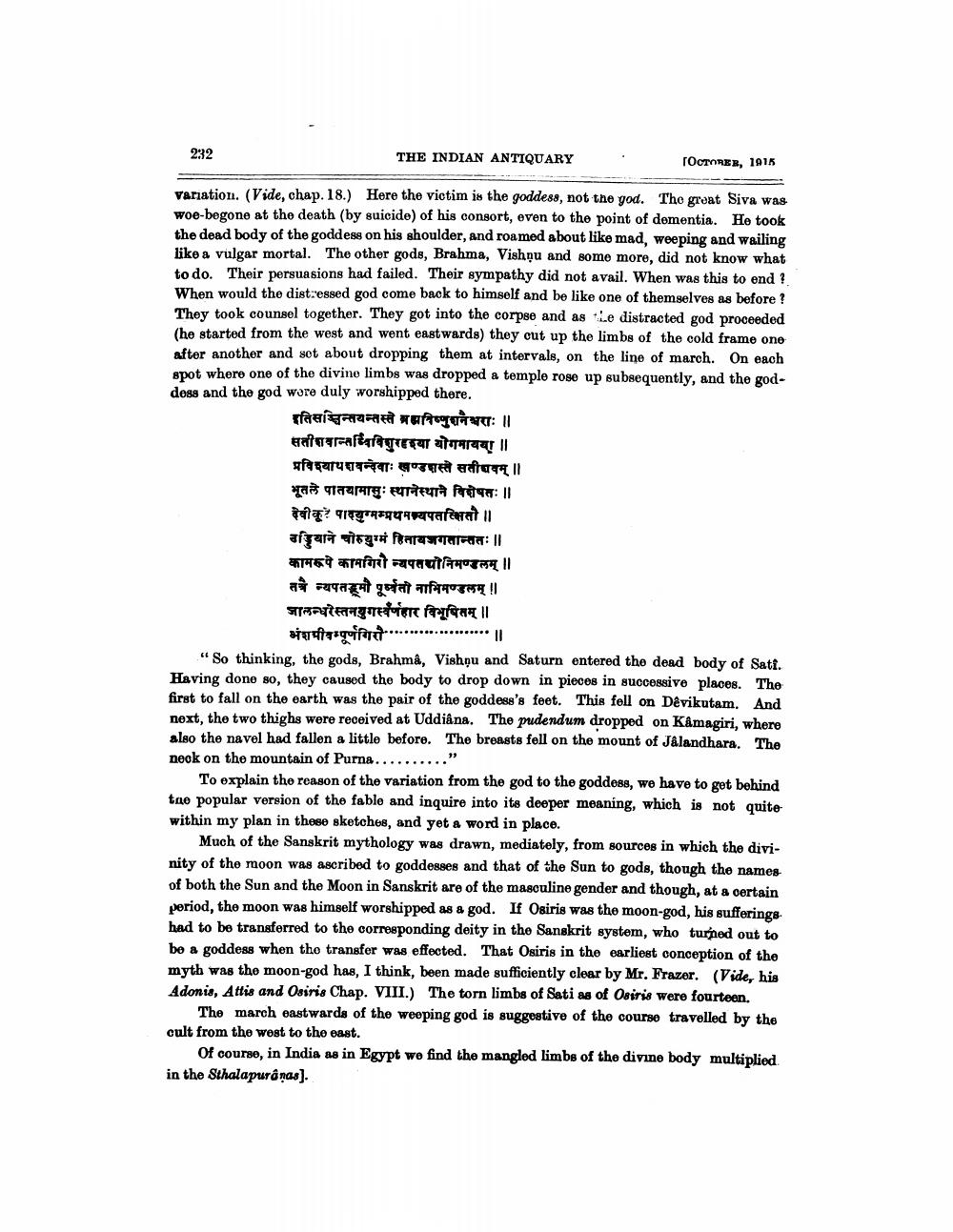________________
232
THE INDIAN ANTIQUARY
OCTOBER, 1915
Variation. (Vide, chap. 18.) Here the victim is the goddess, not the god. The great Siva was woe-begone at the death (by suicide) of his consort, even to the point of dementia. He took the dead body of the goddess on his shoulder, and roamed about like mad, weeping and wailing like a vulgar mortal. The other gods, Brahma, Vishņu and some more, did not know what to do. Their persuasions had failed. Their sympathy did not avail. When was this to end ? When would the distressed god come back to himself and be like one of themselves as before ? They took counsel together. They got into the corpse and as the distracted god proceeded (he started from the west and went eastwards) they cut up the limbs of the cold frame one after another and sot about dropping them at intervals, on the line of march. On each Apot where one of the divino limbs was dropped a temple rose up subsequently, and the goddoss and the god wore duly worshipped there.
इतिसश्चिन्तयन्तस्ते ब्रह्मविष्णुचनश्चराः ॥ सतीशवान्तम्विविशुरहश्या योगमायया ॥ प्रविश्याथदावन्देवाः खण्डशास्ते सतीचवम् ।। भूतले पातयामासुः स्थानेस्थाने विशेषतः ॥ देवीकृ? पादयुग्मम्प्रथमायपतक्षितो॥ नड्डियाने चोरुयुग्मं हिनायजगतान्ततः ॥ कामरूपे कामगिरी न्यपतयोनिमण्डलम् ॥ तत्रै न्यपतडूमौ पूर्वतो नानिमण्डलम् !! जालन्धरेस्तनयुगस्वर्णहार विभूषितम् ||
integrita..................* || "So thinking, the gods, Brahma, Vishņu and Saturn entered the dead body of Sati. Having done so, they caused the body to drop down in pieces in successive places. The first to fall on the earth was the pair of the goddess's feet. This fell on Devikutam. And next, the two thighs were received at Uddiâna. The pudendum dropped on Kamagiri, where also the navel had fallen a little before. The breasts fell on the mount of Jalandhara. The neok on the mountain of Purna......
To explain the reason of the variation from the god to the goddess, we have to get behind the popular version of the fable and inquire into its deeper meaning, which is not quite within my plan in these sketches, and yet a word in place.
Much of the Sanskrit mythology was drawn, mediately, from sources in which the divinity of the moon was ascribed to goddesses and that of the Sun to gods, though the names of both the Sun and the Moon in Sanskrit are of the masculine gender and though, at a certain period, the moon was himself worshipped as a god. If Osiris was the moon-god, his sufferingshad to be transferred to the corresponding deity in the Sanskrit system, who turned out to be a goddess when tho transfer was effected. That Osiris in the earliest conception of the myth was the moon-god has, I think, been made sufficiently clear by Mr. Frazer. (Vide, his Adonis, Attis and Osiris Chap. VIII.) The torn limbs of Sati as of Osiris were fourteen.
The march eastwards of the weeping god is suggestive of the course travelled by the cult from the west to the east.
Of course, in India as in Egypt we find the mangled limbs of the divine body multiplied in the Sthalapuranas).




